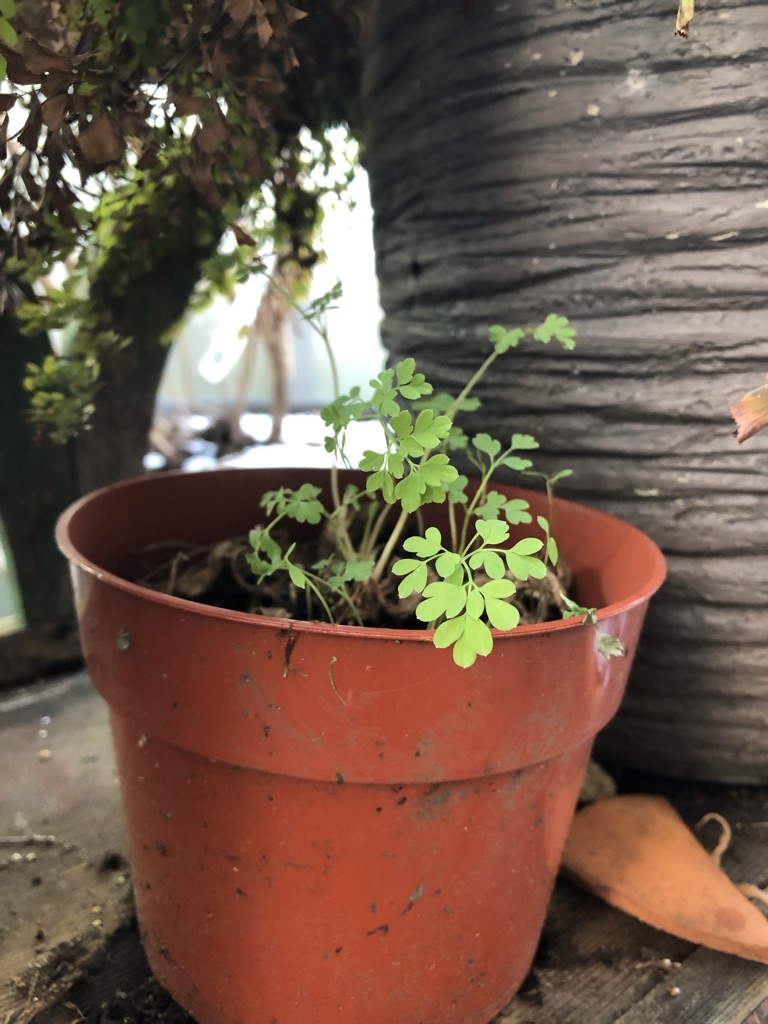
That Corydalis lutea. Familiar to so many gardeners — such a pretty little spreader, welcome ground cover, easy to care for and with the sweetest yellow flowers (I promise to show you some later this Spring). And surprisingly tough to find at Garden Centres — probably because most gardeners have a gardening friend who’s happy to give them a clump. I had oodles of plants “back on the island” — and oodles of gardening friends there who would happily have shared. But they were there and I was here and the nurseries were not helpful. My friend Alison to the rescue! She potted up a small plant for me and brought it over last summer (via sailboat and bike, I believe). And living up to its low-maintenance, high-tolerance reputation, it has delighted me by emerging from its long winter nap. The best gardens, in my opinion, are full of gifts and stories. . .
It’s been a long while since I posted here about my terrace garden — not a conventional garden, which would be tough on the roof of a four storey building, but rather a fairly dense arrangement of annuals, perennials, shrubs, and trees, all grown in containers. I do wander out there somewhat regularly with my camera for Instagram, but nothing here since last summer, and not much of that once the record-shattering temperatures of last year’s heat dome and subsequent drought hit. . . followed, in the fall, by more record-breaking, the “atmospheric river” of rain that damaged so many homes and infrastructure in our province.
You will find a few more sustained posts about my adaptation to a container gardening on an urban rooftop terrace (after years of nurturing a seaside cottage garden on a small island) here and here and here and here and here — This is probably the best for giving a sense of the garden after our first year here, and it also has links to some virtual visits to some wonderful gardens designed and cared for by three readers in our community — Wendy in England, Ali on an island in BC’s Salish Sea, and Eleonore in Germany. Because I’ve had requests, I’ve edited to add a link to a post with an early schematic and another with an inventory of the plants we had our first summer here.
But having had environmental challenges last summer and then again last fall, struggling to keep plants cool and hydrated one season, and then seeing them waterlogged and wind-beaten through the fall storms, we’re facing another challenge in the weeks and perhaps months ahead. This time, the problems have to do with maintenance and remedial work to the building envelope. Work that we voted in favour of, work that we’re glad our fellow condo owners also approved, work that we’re even content to pay a significant levy for, ensuring, as it does, the ongoing good condition of our home. However. This month, as the months-long project began, it did so on the rooftop four floors above us, with debris (scraped-off paint, dirt, moss, etc) landing on our terrace (which forms the roof of the four storeys of the contiguous lower portion of the building).
The work will progress from there down the walls and balconies of the building between our floor and the penthouses. . . .and it may or may not be necessary for us to move (an unthinkably huge whack of!) containers and furniture to allow access and staging of equipment. So.
Reminding ourselves that we’re heading off to Italy in two weeks, and perhaps all will be done when we get back?
And meanwhile, although many of the plants are looking quite woebegone after the trials and tribulations of last year and then the insult and assault of noise and debris. . . .
There are nonetheless signs of hope . . . and ample cause for celebration if I push aside my grumbles and just look. . .
As the sarcococca (Common name: Sweet box) was just gasping out its last sweet fragrant breaths (we have two pots of these now, for maximum spirit-lifting in those tough months between late November (rarely do the blossoms open this early, but the buds are visible and I begin imagining. . . ) and the end of February. . .
Just as the sarcococca was almost retreating back into its tranquil dark green hunkering in corners strategically chosen for scent proximity, then, the hellebores began to bloom . . . In a conventional garden, hellebores don’t generally respond well to transplanting, but we’ve shifted whole pots and are gradually finding spots that suit. This was a happy plant a few weeks ago, although the current situation is going to require a fairly surgical approach (leaves in very sad condition right now).
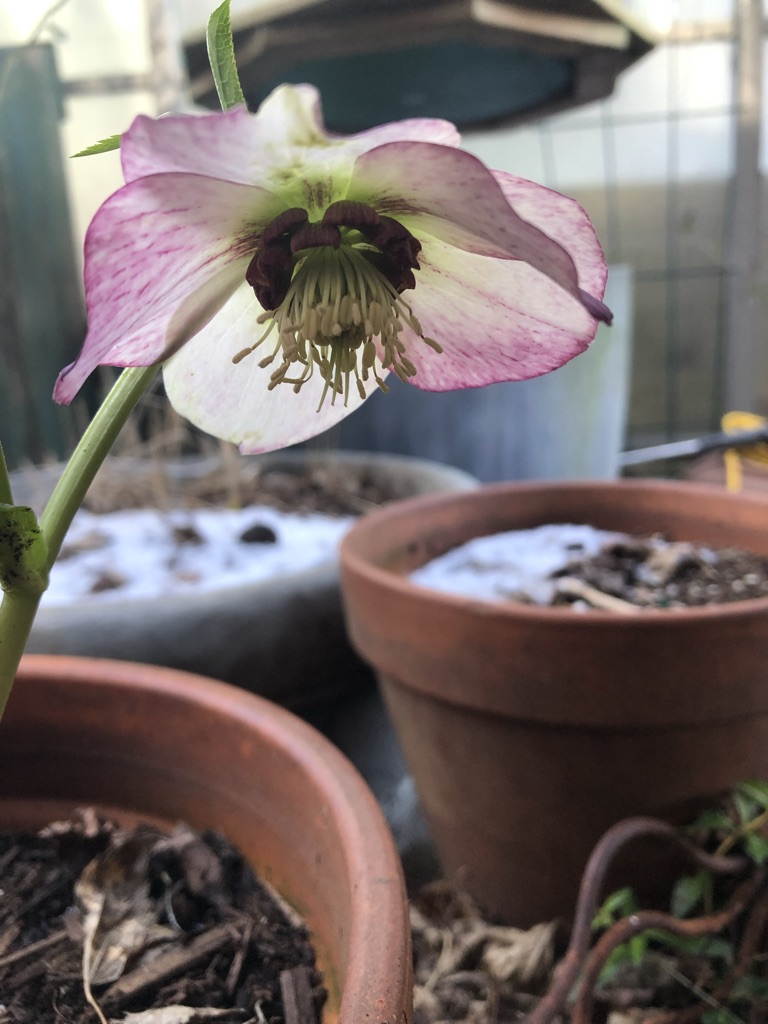
This white-flowered hellebore across the way, though — ever so happy with a move last winter. Besides exposure to sun, an important consideration here is the dripline from the roof overhang above us. Sheltered from that, a pot won’t get much water at all and needs regular attention — as is the case with any plants on our front balcony, which is where this one used to live. . .
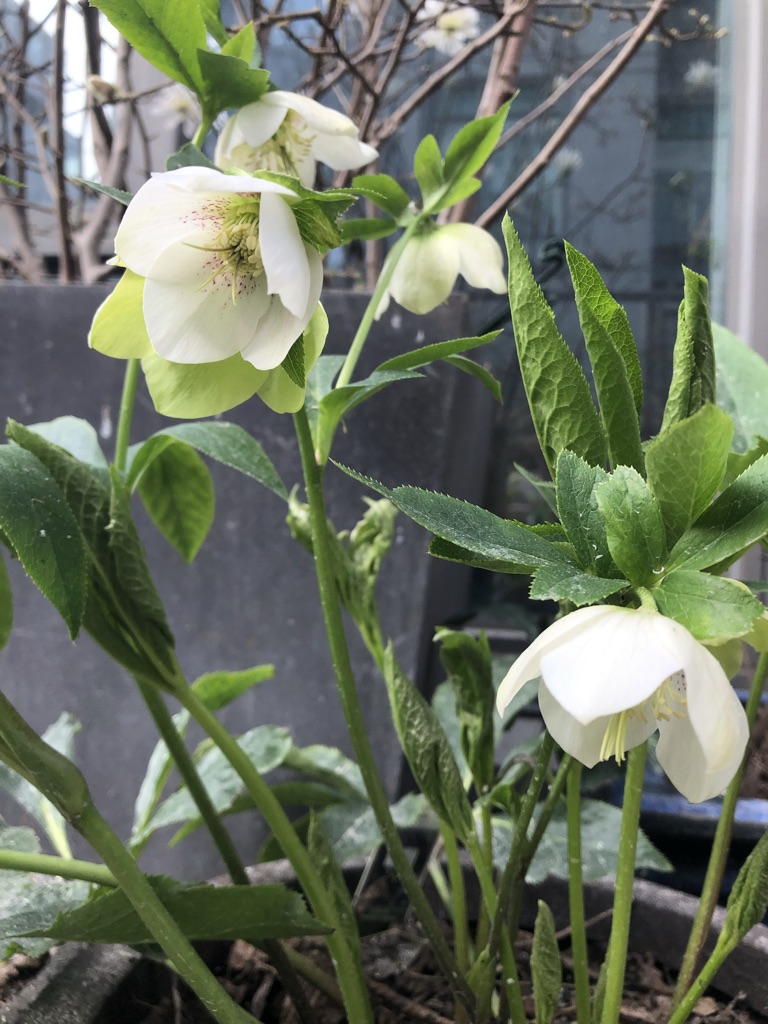
Clearly thriving here though . . . (and perhaps you can spot the pink hyacinth in the olive-oil can just blurring into background below)
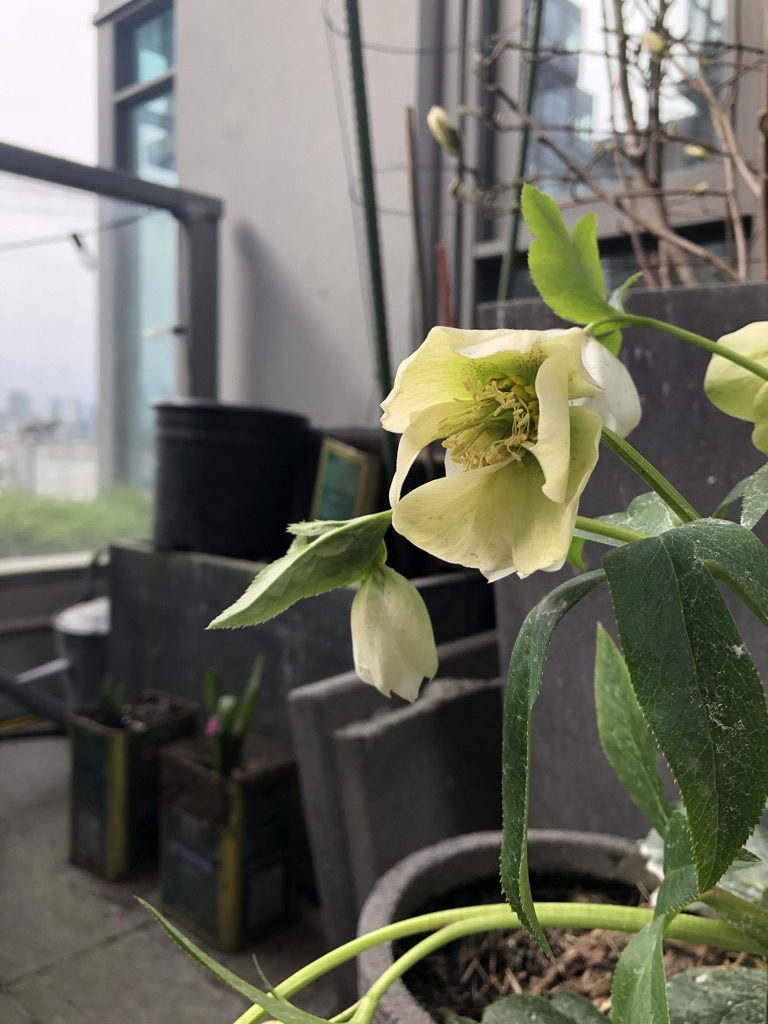
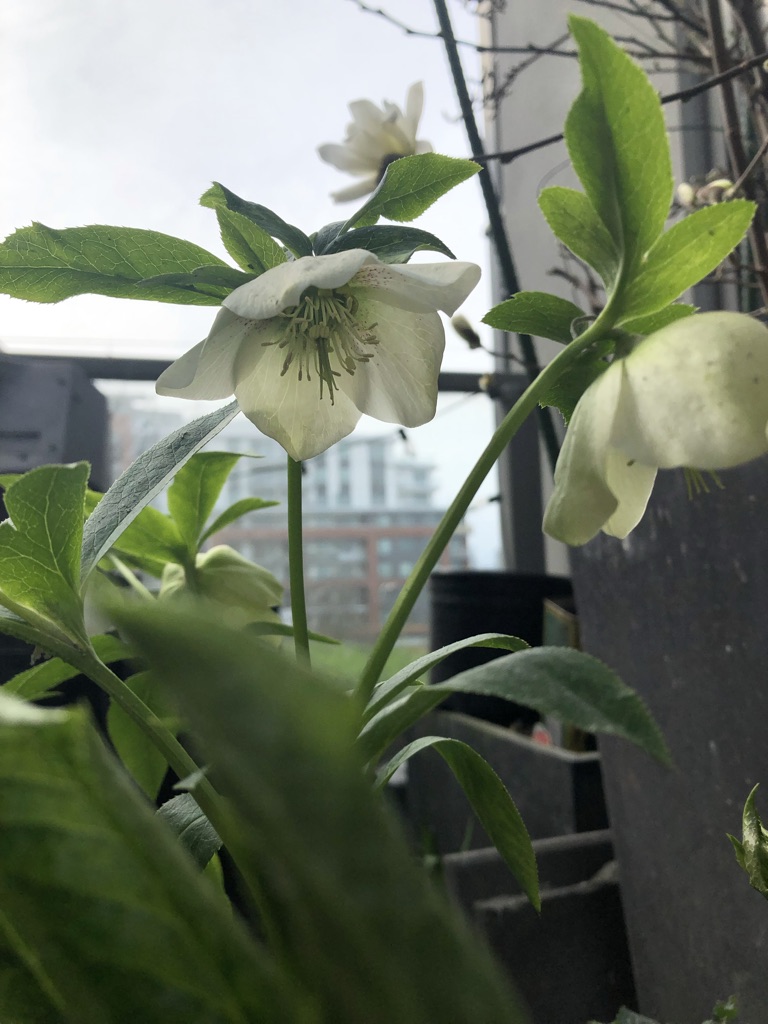
The white hellebore’s pot is set just in front of the much larger pot that holds a Magnolia stellata (Star magnolia, left for us by the previous owners) — and if you look carefully at the photos above, you might just imagine the conversation between those creamy blossoms. The magnolia sits against one of the windows in our main living space (living-diningroom-kitchen) — and watching its furry buds swell in the late winter months, watching the furry carapaces eventually split and be shucked off by the many-petalled force within, watching the petals fan out to catch raindrops and trace wind patterns, this watching has lent joy and hope to the grimness of the last few weeks. Well played, white blooms, well played. Stellar, in fact. . .
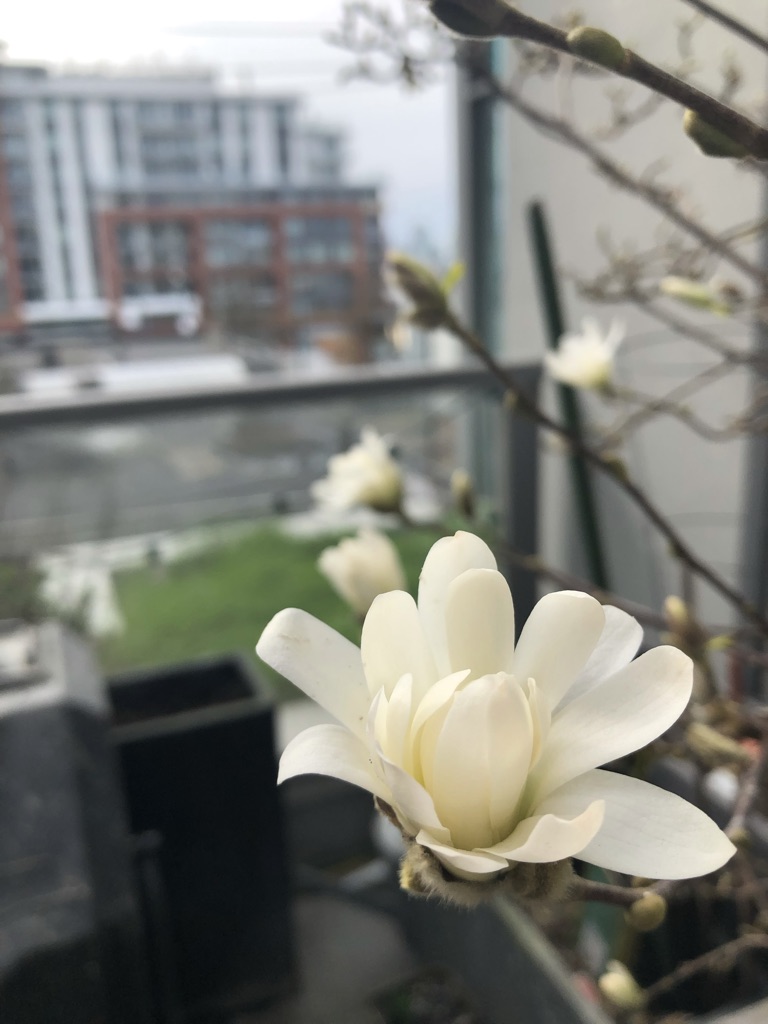
Sarcococca, hellebores, magnolia — all these white blooms, and I should also have mentioned the spiky flowers of that very serviceable bulwark of so many gardens, the Cherry Laurel (Prunus laurocerasus). I would never have chosen this for the limited space we have here (another –large! — pot left by the former owners), but its evergreen profile is surprisingly welcome in the winter, and the last few years it’s begun flowering more prolifically. Late midwinter blooms are always a hit with me, especially the fragrant ones, as these are. And the pollinators are grateful. No Cherry Laurel photos, but here’s a link to an article about the shrub, if you’re interested. Bear in mind, though, that this is an invasive plant, and toxic to humans and their pets. So . . .
Not all white blooms here (I’d never have the discipline!). Tucked in under one of the ornamental maples ( which just now is very cautiously unfurling the chilly fingers of its sweet green leaves) is a Brunnera macrophylla “Jack Frost.”
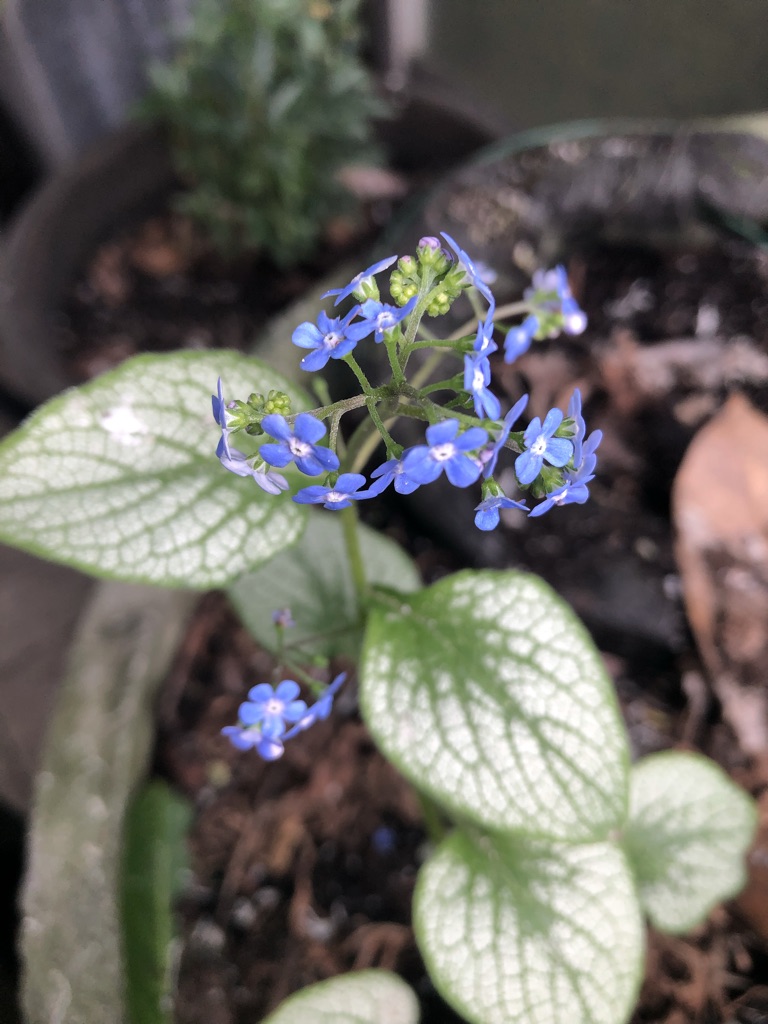
And we have Yellow! (although no photo to prove it) Those previous owners also left us a forsythia. Its floral output has been stingy for a few years; it got a stern-talking to, some pruning, and some generous feeding over the past year or so, and it’s putting on a slightly better show this Spring. That yellow borders on being too aggressive for me in other seasons, but I welcome it against the grey, wet, urban concrete of March.
Still, if the current disruption occasions an overhaul of our garden plan (such as it is), that forsythia could be replaced by the local hero, the indigenous Red-flowering Currant (Ribes sanguineum). We squeezed one into a back row last summer . . . and it’s doing this right now.
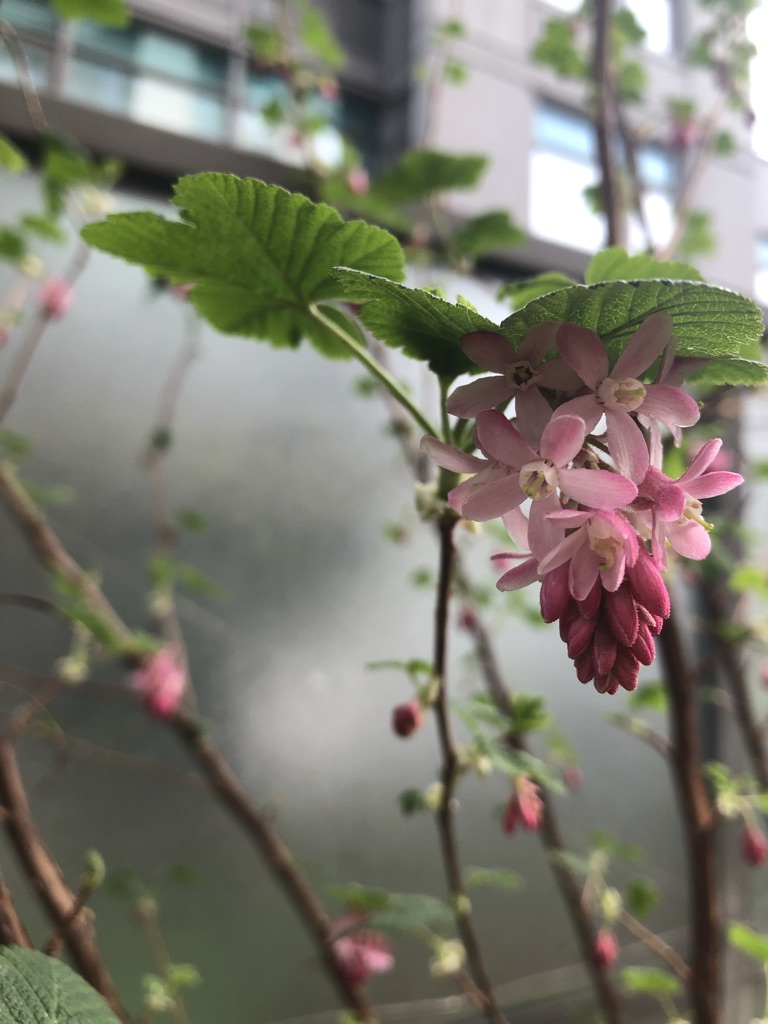
I’ve already seen hummingbirds methodically working their way up a branch, dipping its bill into each opened flower.
And it probably had much to do with these fellows crawling out for a look around (and they will be fellows — the first ones out of the tubes always are, so that they’re ready and available for fertilizing the females who emerge a day or two later)
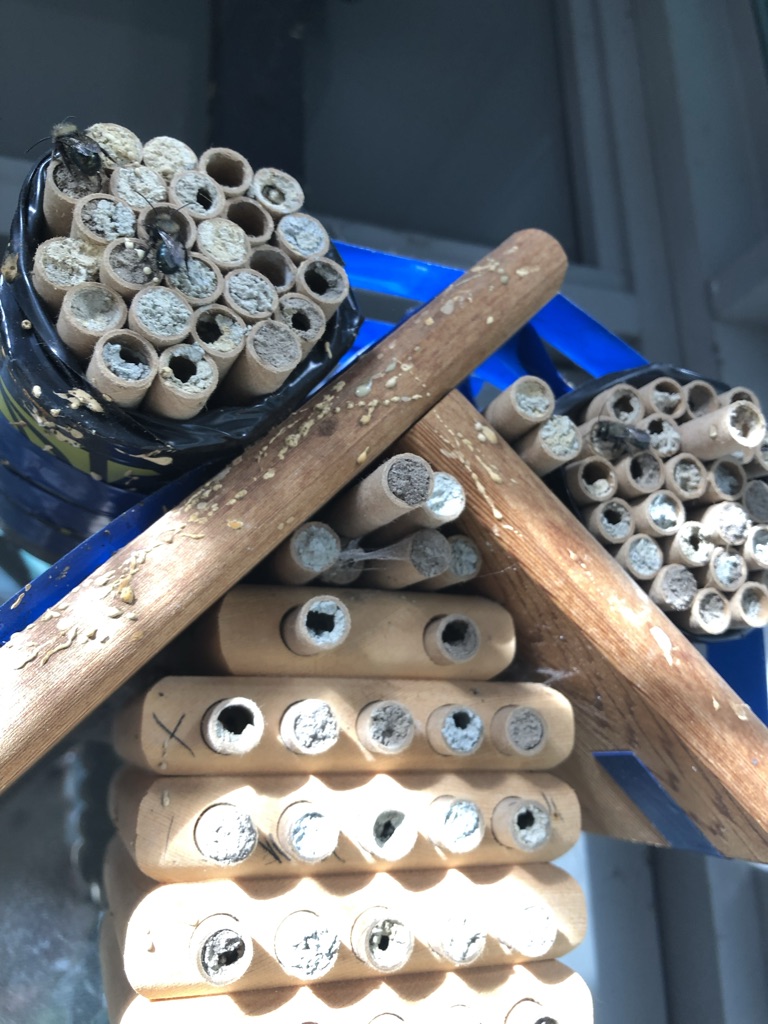
That slice of sunlight and the pre-programmed ability to sense pollen in the ‘hood coaxed our Mason Bees out in what has become one of the most meaningful markers of Spring for Pater and I since we moved here six years ago. The bees have been emerging here and filling tubes with cocoons for the following year since 2018 — so this is our fifth year watching them and cheering on their work. It’s thanks to them (among other pollinators) that our three little apple trees have borne enough fruit that I can make pies each fall. . .
Sadly, we won’t be here to watch the apple trees bloom, to see the mason bees trace a route back and forth between those blossoms and their nesting tubes. We missed that show back in 2019 as well, I see from looking back at a blithely unaware pre-pandemic post. . . .
Nor are we likely back to see lily-of-the-valley bloom for the first time on our terrace garden; still, I’m already thrilled just seeing that this best-birthday-gift-ever from my (baby) sister survived the summer’s heat and drought, the fall’s constant drenching, the winter’s 10-below C nights . . .
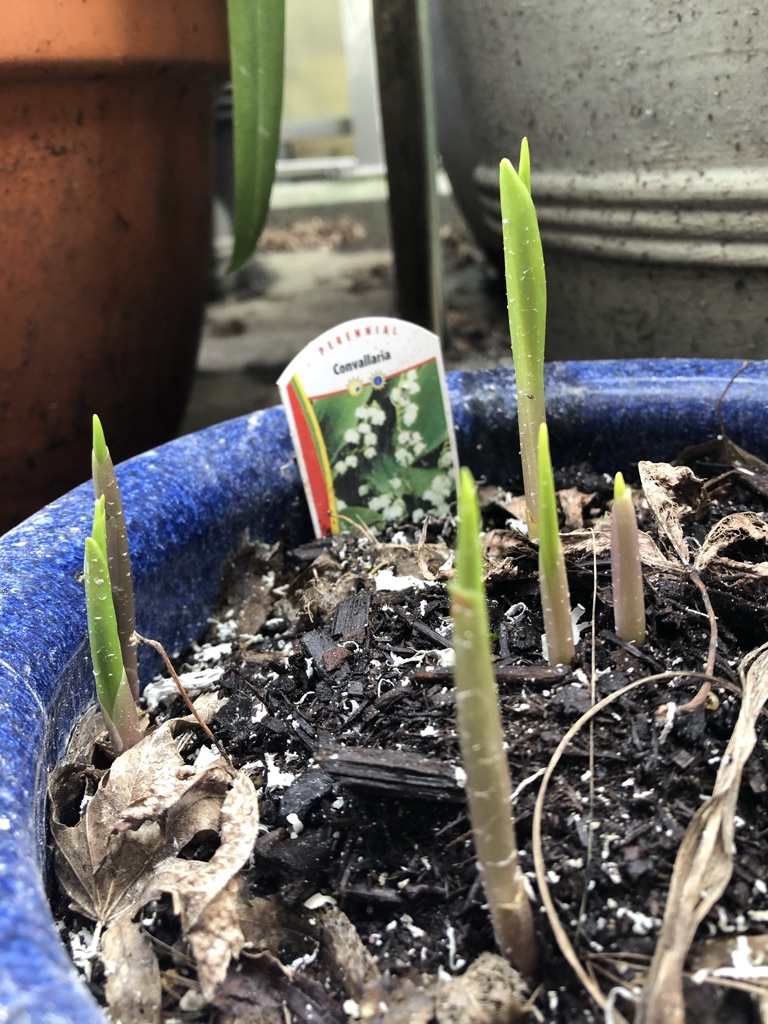
She gave me two pots, each a different variety, knowing that I’d been wanting a plant for years and frustrated (as with the Corydalis lutea) that I couldn’t just go back to my old garden and dig up a small patch. Each year on my May birthday, I’ve minded not being able to put a few in the dainty white Coalport bud vase my Mom gave me some 50 birthdays ago. And now I will be able to again. Not this year, but that’s the thing about gardens — they always have you looking ahead. . . .
Even if we’re gathering moss, showing our age, as we look to future gardens. . . .
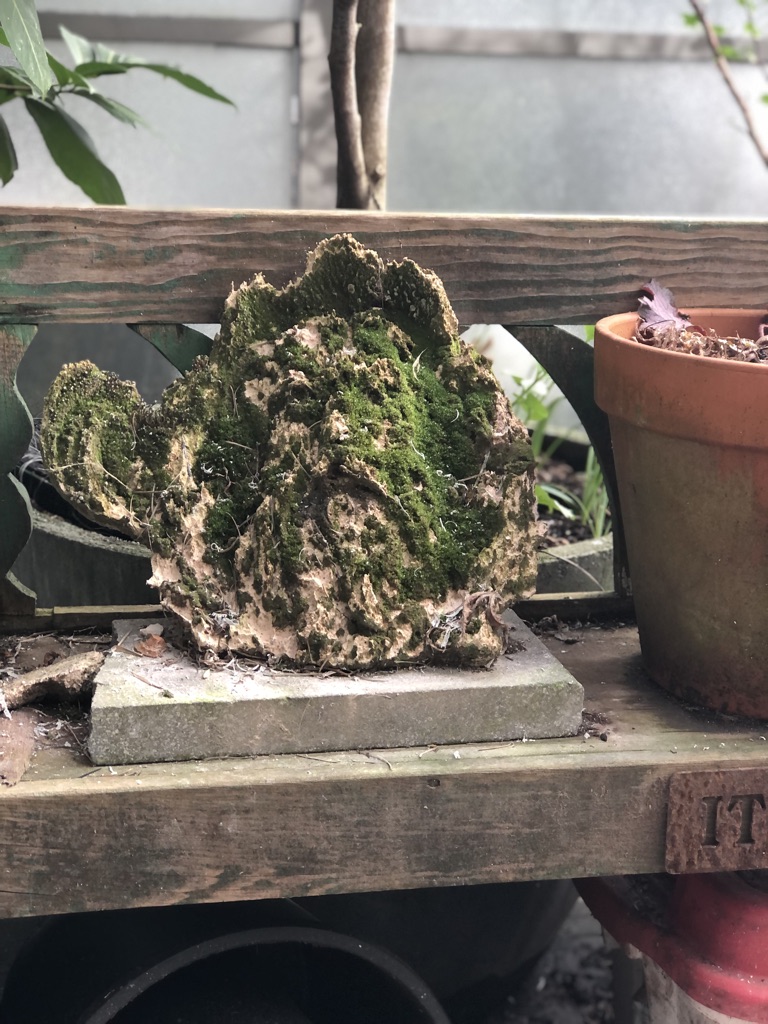
I hope you’ve enjoyed this little tour ’round my terrace. Not sure what it’s going to look like by the time we get back from our travels, although we still have a bit of time with it before we leave and we have some good care for it while we’re away. I’m oddly pleased to note how much I will miss it, to recognize that while in Italy, I’ll be mentally tracking the garden sequences based on the accumulating seasons we’ve already had here. Such a different garden than our old one, but despite being on a rooftop, a collection of plants in containers, this little micro-environment grounds me and ties me to place. . . Might be trite, but I find reassurance in recognizing (again) that change can lead to different kinds of contentment . . . (and sometimes you take your reassurance where you find it, triteness and all!)
Your turn now, should you wish to comment. Or just wave. I’ll be here. . . .
xo,
f
My little patio garden needs a complete overhaul this year. None of the herbs which usually overwinter seem to have made it through. I too garden in containers, a mix of the herbs and flowers. One of my very large containers seems to have developed a drainage problem and will have to be completely emptied in order to fix the problem. Yesterday I bought a new nozzle for the hose and some potting soil, a start. My plan was to begin getting the planters ready today but it is so cold and windy and probably will be for the next few days , so I will probably wait a bit longer to begin. So that’s the back of my home. My small front yard is quite shady. the Hostas I have planted over the years provide some pretty greenery but I really would like a bit more color. I will put in some pansys, always reliable but their season is limited. I am drawing inspiration from your garden.
Author
I’m finding that overhauls and replacements are needed more regularly for container gardening than in a conventional garden where the ecosystem develops its own checks and balances (if plantings are made with consideration of plants’ needs). . . That’s a big job with your large container — you’re wise to wait a bit so at least you’re not out in the cold doing it!
Not sure what zone you’re in, but that little Corydalis Lutea might fit in with your hostas. I’d also be tempted to tuck in a few Bleeding Hearts (Dicentra spectabilis or some such). . . (Wendy’s right, though — the corydalis does spread, although easily pulled up).
I’m wondering if the location of your plants affects when they flower . Are they earlier or later than in gardens you pass in the area ? My Magnolia Stellata ( in a pot as it wouldn’t like my soil ) is still tightly curled up despite recent sunshine . My Lily of The Valley are at about the same stage as yours as they march around the garden . At least you have them under control there . Those Corydalis can be naughty too . They seem to leap into every pot I have . My Hostas often end up sharing with Corydalis , but they are lovely . We are busy catching up after our recent trip away & have come back to primroses everywhere , from almost yellow ones to almost white ones . I love them . It’s unseasonably warm for them just now but they’ll be happy in a couple of days . Sleet is forecast .
Author
Because the garden is south-facing, but shaded, to the south, by a (contiguous) building 15 or so metres away, we get some funny little zones going on. And then being on a roof. . . So I find some plants flower later and some earlier than the same plants in the neighbourhood (and the neighbourhood near us features two or three-storey houses on good-sized city lots, very leafy, many large trees so lots of shade). There’s actually surprising range of flowering times, I suppose because of hilliness and changing proximity to the water (which is only a 15-minuter walk from here).
I never minded my Lily of the Valley spreading where we were before as I had so much space and they worked nicely at the edge of an adjoining “wild space.” And the Corydalis spreading never bothered me either — so light and lacy, softening and unifying. Creeping Jenny (lysimachia nummularia) was another story altogether!
Primroses! I love those creamiest ones, palest buttery yellow. . .
Ah, spring at the coast! Here on the prairie, we’re enjoying the very first signs of spring. Half the ground is exposed, but the other half is still snow covered. Water is running, geese are flying overhead, and apparently the gophers have come out of hibernation, but it will be a little while before any green shoots appear. We’ll be in Vancouver next week, however, and Victoria the week after. Can hardly wait to see flowers!
Author
Oh, it will be like watching a black-and-white film turn technicolour! Even the urban grey concrete of a drizzly day can’t dull our Spring on the Coast once it gets going. And all the cherry trees are ready to put on a big show, just for you!
I’m just waving since, as you know, I am NOT the gardener at our house. I barely even know the names of the bedding plants we buy for our flower garden, encouraging Stu to get those little white ones with the purple spots again…. or something. Ha. Now my mum, she could have a long natter with you and Wendy about her flower garden that was. She loved her flowers.
Author
I do know that about you — thanks for waving, and enjoy your visit with your mum this week. xo
The best gardens are full of gifts and stories. I’m not really a gardener but I’ve been enjoying learning, experimenting and taking pleasure in the surprises when something new appears! It’s been a year since we’ve moved so have received gifts from each of the seasons. Thanks for the beautiful photos 🌸
Author
Well, that sounds like a gardener to me “learning, experimenting and taking pleasure in the surprises.” Fun to have a new garden to learn and grow in.
Lovely! I’m a big fan of hellebores, and it’s really nice to see some native shrubs (that red-flowering currant, and you highlighted a snowberry in one of your previous posts) successfully grown in pots. How big are the pots you have those two in? As you know I’m keen to have a lot of native plants in our patio garden— which will involve pots or, at most, some raised beds. So I’m keen to get a handle on their requirements. I don’t suppose you’d ever sketch out a rough garden plan to share with us so we could get more of the big picture? I am all demands today, my apologies— hope you’ll take it as enthusiasm for our green friends, and not undue pressure.
Author
First of all, the snowberry is no longer with us (the Ribes sanguineum is in that space). . . . it was left here by the previous owners and I loved having a native shrub here (we had so many in a strip of our yard that we left as “managed wild”). But it never thrived, was plagued by aphids each summer. I would love to try another in a few years — it flowered too late for our mason bees, but its small blooms nourished many other bees until late summer — rarely a berry on it, though. I would still try it, if I were you. So much of what works is situational . . . The pots for the shrubs are large — 18-24 inches high, the same in diameter. I did post a diagram of the garden plan a few years ago and have been trying to find that post. When I do I’ll link to it in a future garden post. But might be a while, and I’m afraid I wouldn’t think of doing an updated version until this noisy, dirty, necessary work is all done outside 😉 (so I’m not feeling any undue pressure, just horticultural enthusiasm, always appreciated!
Author
I found that link! This post has a diagram of the garden as it was in 2017. And this earlier one walks you ’round the space while taking inventory.
Fantastic! Thanks so much for pointing me to both of those prior tours. They are super helpful! I hope the repair work wraps up quickly and doesn’t have too much of an impact on your garden.
Author
You’re welcome — and thanks for the hope!
What are gardens without memories,gifts and stories! Your bees look best ever,don’t they?
Fingers crossed that your garden will be saved completely during the reno….but,first Italy….
Dottoressa
Author
The bee population went crazy last year, you’re right! We had to buy a second little house and also improvise some new shelters. . .
Yes, Italy first. . . . soon. . . wish conditions were good to hop across the Adriatic for a visit. xo
“The best gardens…are full of gifts and stories.” I’ll be writing those words in my journal. Beautifully said. I thoroughly enjoyed this tour of your patio garden. That red currant bush is simply stunning. How much fun to be anticipating Italy!
Author
Thanks, Lorrie! And yes, it is fun (still a bit stressful, but definitely also fun 😉
I’m having my first pangs of missing gardening, and walked through a small local nursery in search of inspiration. Nothing stunning, but I’m told that there’s another spectacular nursery that I must visit. I want a blood orange and a Meyer lemon, and need to sort out annuals for the existing large pots on our wide front steps – the oleander planted in them is struggling, so I imagine I’ll probably offer to take over from the gardeners and see what I can do, even if what I can do is pull them out and plant something that wants to grow there. I’m guessing that things that will do well here are similar to what works in Southern California (and I’m certainly seeing some of the same plants), so the learning curve is engaged!
Author
Oh, there are few better ways, in my estimation, to really nest into a new home, than to do whatever kind of gardening works. For me, here, containers have done the trick . . . and if you can fill yours with citrus fruit, well!! Have fun!
So enjoyed it! Thank you:)
Author
You’re welcome! Hope to have you sitting in the garden again some day. . . xo
In my lakeside garden there is a story to almost every perennial. And the garden of the temporary home I am living in is a generous loan I feel grateful for every day. It was so beautiful to watch the first shoots of plants I never put there myself – like gifts from a distant generation. But these last two days we have been having some snow (the first snow in all this winter!), and I fear for the hortensias.
Some strange ideas have crossed my mind lately: with food prices going up by the day I wonder if I should not start a vegetable patch…
Author
I’m so pleased to learn that you’re enjoying your new garden — I know it was such a wrench to leave the old one.
And yes, I think that anyone with a patch of ground might think of growing a few veggies . . .